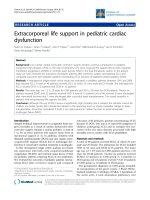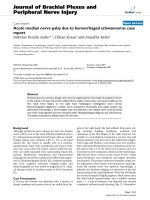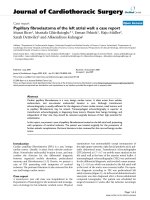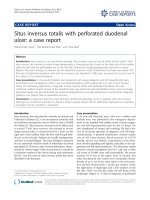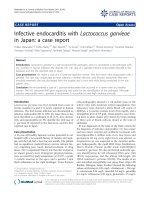Báo cáo y học: "Extra-corporeal life support for near-fatal multi-drug intoxication: a case report" ppt
Bạn đang xem bản rút gọn của tài liệu. Xem và tải ngay bản đầy đủ của tài liệu tại đây (482.38 KB, 5 trang )
CAS E REP O R T Open Access
Extra-corporeal life support for near-fatal
multi-drug intoxication: a case report
Roberto Rona
1*
, Barbara Cortinovis
1
, Roberto Marcolin
1
, Nicolò Patroniti
2
, Stefano Isgrò
2
, Chiara Marelli
1
and
Roberto Fumagalli
2
Abstract
Introduction: Severe mixed b-blocker and calcium channel blocker intoxication presents a significant risk for
patient mortality. Although treatment is well-established, it sporadically fails to support the patient through massive
overdoses, thus requiring non-conventional treatments. We report the use of extra-corporeal life support in a
patient with refractory hemodynamic impairment due to multi-drug intoxication. Although sometimes used in
clinical practice, extra-corporeal membrane oxygenation for intoxications has rarely been reported.
Case presentation: A 36-year-old Caucasian man presented to our hospital with refractory hypotension, severe
cardiac insufficiency and multi-organ failure due to mixed intoxication with atenolol, nifedipine, Lacidipine and
sertraline. Together with standard treatment, we performed extra-corporeal membrane oxygenation to overcome
refractory cardiogenic shock and lead the patient to achieve a full recovery.
Conclusion: Standard of care for b-blocker and calcium channel blocker intoxication is well-defined and
condensed into protocols of treatment. Although aimed at clearing the noxious agents from the patient’s system,
standard measures may fail to provide adequate hemodynamic support to allow recovery. In selected cases, extra-
corporeal membrane oxygenation could be considered a bridge to drug clearance while preventing multi-organ
failure due to profound shock.
Introduction
b-blocker (BB) and calcium channel blocker (CCB) are
the most common cardiovascular medication classes
reported in the database of the American Association of
Poison Control Centers Toxic Exposure Surveillance
System [1]. BB overdose represents about 1% of patients
with drug intoxication admitted to intensive care units.
Fatalities are rare but not negligible, with a reported
rate of about 0.5% and about 20 deaths per year in the
United Kingdom. C CB and BB poisoning represent
more than 65% of overall deaths caused by cardiov ascu-
lar medications [2].
The most severe forms, which account for 20% of all
BB overdoses, are usually due to propranolol ingestion
because of its rapid absorption. In the American experi-
ence, proprano lol is responsible for the majority of fatal
cases (70%), f ollowed by atenolol (20%). The patients’
clinical presentation and care in cases of significant BB
overdose are a direct consequence of cardiovascular
depression and the need to reverse it. Critical factors
are timing, type and dosage of the product ingested, the
presence of a synergistic co-ingestant, medical co-mor-
bidities and the patient ’s intent i n ingesting the
medications.
The presence of CCB could make patients particul arly
vulnerable to BB toxicity, because their physiological
and toxic effects are similar [2]. Co-ingestion of psycho-
tropic agents can also worsen the patient’sprognosis
because of respiratory depression [3].
Treatment usually consists of spe cific and non-specific
measure aimed at stabilizing the patient while attempting
to clear the poisoning from the patient’s system. However,
since timing is essential to prevent ing multi-organ dete-
rioration and failure due to profound refractory cardio-
genic shock, a standard approach might not provide
adequate hemodynamic support to achieve this goal until
there is complete drug clearance from the patient’s system.
In this regard, extra-corporeal membrane oxygenation
* Correspondence:
1
Dipartimento di Medicina Perioperatoria e Terapia Intensiva, Azienda
Ospedaliera San Gerardo di Monza, via Pergolesi 33, Milan, Italy
Full list of author information is available at the end of the article
Rona et al. Journal of Medical Case Reports 2011, 5:231
/>JOURNAL OF MEDICAL
CASE REPORTS
© 2011 Rona et al; licensee BioMed Central Ltd. This is an Open Access article distributed under the terms of the Cr eative Commons
Attribution License (http://creative commons.org/licenses/by/2 .0), which permits unrestrict ed use , distribution, and reproduction in
any medium, provided the original work is properly cited.
(ECMO) might offer a valuable bridge to drug clearance
while protecting organ function from irreversible damage.
Case presentation
A 36-year-old Caucasian man with a history of hyper-
tension, depression, bipolar disorder and two past sui-
cide attempts was brought to our emergency
department two hours following voluntary ingestion of a
total estimated amount of 10 g of atenolol in association
with an unknown amount of sertraline, nifedi pine, Laci-
dipine and fluoxetinee.
Upon arrival, he presented with a decre ased level of
consciousness, shortness of breath, hypoxemia (arterial
oxygen saturation, 91%) and hypotension (blood pres-
sure (BP), 80/40 mmHg; heart rate (HR), 80 beats/min-
ute). A 12-lead electrocardiogram (ECG) showed normal
sinus rhythm, PR interval 168 milliseconds, prolonged
corrected QT time 448 milliseconds and QRS w idening
133 milliseconds. The results of his routine labo ratory
tests, including glucose, an electrolyte panel, liver func-
tion tests and coagul ation were normal, with the excep-
tion of mild renal impairment (blood urea nitrogen 46
mg/100 mL, creatinine 2.2 mg/100 mL).
Briefly afterward the patient’s condition suddenly dete-
riorated, and he experienced cardiac arrest. He was
resuscitated according t o advanced cardiac life support
(ACLS) protocols, and an effective cardiac rhythm was
regained 30 minutes following the cardiac arrest. How-
ever, he had severe hemodynamic instability, persistent
metabolic acidosis and shock (BP 70/40 mmHg, HR 80
beats/minute), despite adequate fluid resuscitation, the
administration of 100 mEq sodium bicarbonate IV
bolus, very high-dose dopamine (50 μg/kg/minute) and
epinephrine (2.5 μg/kg/minute) infusion.
At the same time, we started specific medical manage-
ment for BB and CCB intoxication, including gastric
lavage followed by gastric administration of 40 g of acti-
vated charcoal, 40 ml IV bolus injection of calcium
chloride, and 5 mg glucagon IV bolus injection per-
formed. Two hours after admission to the emergency
department, the patient was transf erred to our intensive
care unit (ICU).
Upon arrival to the ICU, the patient was unconscious
(Glasgow Coma Scale score 3) without sedation and on
controlled mechanical ventilation. He had persistent
shock with multiple organ failure, refractory metabolic
acidosis (pH 7.22, arterial partial pressure of oxygen
(PaO
2
) 79 mmHg, arterial partial pressure of carbon
dioxide 49 mmHg, base excess -7.4, lactate 9.3 mmol/L)
and oligo-anuric renal failure.
Thespecifictreatmentofhisdrugoverdosewasper-
formed as follows: (1) 40 g of activated charcoal admin-
istration through a nasogastric tube three times daily for
24 hours, (2) whole bowel irrigation with 2 L of
polyethylene glycol, (3) calcium chloride continuous IV
infus ion to provi de a stable slightly supra-normal serum
ionized calcium level (2 mmol/L), (4) glucagon continu-
ous IV infusion at a rate of 5 mg/hour for 20 hours fol-
lowing the first 5 mg loading dose, (5) high-dose insulin
and glucose continuous IV infusions (0.7 to 1.5 IU/kg/
hour and 50 to 100 g/hour, respectively) and (6) single
plasma exchange treatment followed by three days of
high-volume continuous veno-venous hemofiltration
(HV-CVVH) at a 70 to 80 mL/kg/hour ultra-filtration
rate.
His plasma levels of anti-psychotic medications and
CCB were reduced by medical treatment and plasma
exchange. His atenolol level continued to rise for six to
eight hours after toxic ingestion and then started to
decrease with the initiation of HV-CVVH. His atenolol
plasma level norma lized after 72 hours, at which point
the ultra-filtration rate was reduced to 40 mL/kg/hour.
The efficacy of atenolol removal by HV-CVVH can be
assessed on the basis of the trends in plasma and ultra-
filtrate levels outlined in Table 1.
The patient’s cardiac insufficiency required the inser-
tion of a pulmonary artery catheter to guide hemody-
namic optimizatio n, increasing the infusion of inotropes
and vasopressors up to extremely high-dose dopamine
(300 μg/kg/minute) and subsequent epinephrine (15 μg/
kg/minute) and vasopressin (0.03 IU/minute) continuous
infusion, which still did not achieve satisfactory hemody-
namic stability or adequate peripheral tissue perfusion
(BP 80/40 mmHg, HR85 beats/minute, cardiac output
(CO) 4.2 L/minute, mixed venous oxygen saturation
(SvO
2
) 61%, pH 7.18, and lactate 8 mmol/L). An
Table 1 Drug, plasma and ultra-filtrate levels and
clearance
a
Emergency
Department
arrival 60 minutes
after drug
ingestion
After plasma
exchange
therapy 8 hours
after drug
ingestion
After 72 hours
of HV-CVVH
Medication Plasma levels Plasma
levels
Ultra-
filtrate
Plasma
levels
Ultra-
filtrate
Sertraline,
μg/mL
0.55 - - - -
Nifedipine,
μg/mL
2.23 0.45 - - -
Lacidipine,
μg/mL
0.34 - - - -
Fluoxetinee,
μg/mL
0.02 - - - -
Atenolol,
μg/mL
3.95 14.8 6.5 2.1 0.6
a
HV-CVVH, high-volume continuous veno-venous hemofiltration.
The table summarizes plasma sertraline, nifedipine, lacepidine, fluoxetinee,
and atenolol levels upon Emergency Department (ED) arrival. It also shows
the plasma and ultra-filtrate levels, respectively, following plasma exchange
and high-volume continuous veno-venous hemofiltration.
Rona et al. Journal of Medical Case Reports 2011, 5:231
/>Page 2 of 5
echocardiogram confirmed global cardiac hypokinesis
and depressed left ventricular function.
The patient’s young age, relative lack of pre-existing
co-morbidities, potassium levels and failure to accom-
plish satisfactory correction of tissue acidosis led us to
consider extra-corporeal cardiopulmonary support. Two
hours after admission extra-corporeal cardiopulmonary
support (Jostra RotaF low Centrifugal Pump; Maquet,
Jostra Medizintechnik AG, Hirrlingen,Germany)was
started through percutaneous femoral artery and vein
cannulation. Extra-corpo real blood flow was initially set
at 4 L/minute, and gas flow through an artificial lung
was initiated at 2 L/minute of oxygen.
After starting ECMO, vasopressin was discontinued
and both dopamine and epinephrine administration
were quickly tapered (Table 2). His clinical signs of tis-
sue perfusion improved, minimal spontaneous diuresis
resumed and lactic acidosis was corrected. After 24
hours of combined ECMO and HV-CVVH treatment,
his lactate levels had decreased to near physiological
levels (< 2 mmol/L). Specific b-agonist cathecolamines,
such as isopro terenol and dobutamine, were added to
epinephrine while dopamine was replaced with a more
specific vasoconstrictor, such as norepinephrine.
Unexpectedly, the patient ’s severe myocardial impair-
ment was never associated with rhythm disturbance.
Serial 12-lead ECGs revealed moderate sinus bradycar-
dia, but neither atrio-ventricular blocks nor QRS widen-
ing nor cQT interval prolongation was detected, except
on the admission ECG. Therefore, t here was no indica-
tion for cardiac pacing.
After 24 hours, a test of extra-corporeal blood flow
reduction revealed persistent cardiac insufficiency compli-
cated by pulmonary edema (BP 85/40 mmHg, CO 3.9 L/
min, pulmonary capillary wedge pressure 21 mmHg, SvO
2
63% and ratio of PaO
2
to fraction of inspired O
2
<150).
The patient was weaned from ECMO 48 hours later
after a successful flow re duction test. After by-pass
interruption, inotropes and vasopressors were progres-
sively tapered and discon tinued completely on day 6,
when his hemodynamic parameters were completely
within normal range (Figure 1 and Table 2).
The second clinically relevant problem was the extre-
mely low potassium plasma level on admission (< 0.8
mEq/L). Potassium was supplemented by high-dose
potassium chloride continuous IV infusion at a rate of
30 to 35 mEq/hour without successful response. Once
the by-pass was started, the effects of potential sudden
cardiac death due to arrhythmia secondary to electrolyte
derangement was reduce d, thus the IV infusion was
quickly tapered to 10 to 15 mEq/hour without cardiac
rhythm disturbance. The plasma level of potassium nor-
malized only about 12 hours later . Transient hyperkale-
mia was also noted with no ECG abnormalities.
We also observed progressive rhabdomyolysis (m yo-
globinuria, creatine phosphokinase 24,169 IU/mL and
myoglobinemia 14,444 IU/mL) and some skin sub-
ischemic injuries on the right gluteus and second and
thirdlefttoes.Thepatient’s rhabdomyolysis was mana-
ged with high fluid washout and to some extent by HF-
CVVH. His external lesions were dressed daily. All com-
plications resolved without sequelae.
Moderate neurological impairment progressively devel-
oped as a result of the initial anoxic insult. Basal brain CT
and magnetic resonance imaging scans showed bilateral
ischemic dyencephalic lesions. Serial electroencephalograms
confirmed depressed cortical activity with predominant
bilateral theta-delta waves.
An echocardiogram obtained three days before the
patient’s discharge from the ICU showed a light left ven-
tricular hypertrophy, normokinesis and a preserved ejec-
tion fraction (58%). The patient was transferred from
the ICU on day 28 without cardiac, renal or pulmonary
sequelae.
One year after his discharge from the ICU the patient
was not self-sufficient and therefore was living in a
long-term care facility. Although his neurologic perfor-
mance overall had improved over time, he still has
reduced motor skills and impaired coordination, gait
ataxia and mild aphasia.
Discussion
BBs and CCBs offer similar outcomes in patients with
intoxications, consider ing their final effect on inhibiting
Table 2 Time course and dosage of inotropes and vasopressors during ECMO
a
Time since admission, hours
Medication 0 to 2 2 to 4 4 to 6 6 to 8 8 to 10 10 to 12 14 to 16 18 to 20 22 to 24 36 to 38 40 to 42 46 to 48
Dopamine, μg/mL 50 300 150 100 50 30 25 - - - - -
Epinephrine, μg/mL 15 15 15 15 3 3 1 0,4 0,5 - - -
Noradrenaline, μg/mL - - - - - 0.2 0.2 0.2 0,2 0.3 0.05 -
Dobutamine, μg/mL - - - - - 8 8 12 16 82-
Isoproterenol, μg/mL - - - - - - - - 5.5 5.5 0.5 -
ECMO
a
ECMO, extra-corporeal membrane oxygenation.
Rona et al. Journal of Medical Case Reports 2011, 5:231
/>Page 3 of 5
calcium influx into the cells. As a consequence of b-
receptor activation, the G proteins responsible for con-
verting ATP to cyclic adenosine monophosphate are
blocked, thus reducing cytosolic calcium, which is essen-
tial for muscle contraction [1,2]. On the other hand,
CCBs antagonize cardiac and smooth muscle cell L-type
calcium channels.
In addit ion, BBs act as membrane stabilizers through
direct inhibition of sodium influx in myocardial cells
and widening of QRS because of prolongation of phase
0 of the action potential. The clinical effects of mixed
intoxication consist of profound cardiovascular depres-
sion due to cardiac contractility failure, hemodynamic
deterioration due to cardiogenic shock and sinus rhythm
disturbances ranging from bradycardia to various
degrees of atrio-ventricular blocks and asystole [4]. Of
note, in our present case, we did not observe major car-
diac rhythm disturbances. The near-normal heart rate
(70 to 90 beats/minute) that we observed can probably
be ascribed to the intense chron otropic effect of high-
dose vasoactive drug therapy that counterbalanced BB-
and CCB-induced bradycardia.
Although the cardiovascular system represents the tar-
get organ, neurologic impairment could present as an
expression of inadequate brain perfusion or direct
sedative effects, especially of more lipophilic agents such
as propranolol [4]. Although non-peculiar, coma, sei-
zures and central respiratory depression are not entir ely
uncommon [5].
Pre-existing conditions such as congestive heart failure
[4] and newly acquired conditions such as hyperkalemia,
acidosis and co-ingestants with similar physiologic
effects may further enhance toxicity. Therefore, it
appears essential to implement a system to establish
hemodynamic stability through phases of multi-organ
dysfunction until drug metabolism and r emoval have
been achieved.
Details about specific manage ment of BB and CCB
intoxication are beyond the aim of this work, as it is
an extensive r eview of types and technical features of
ECMO. Nevertheless, it is important to emphasize
that currently available guidelines and recommenda-
tions include extra-corporeal life support (ECLS), spe-
cifically ECMO, in exceptional therapies f or refractory
cardiac arrest and heart failure in BB, CCB and mem-
brane-stabilizing agents (such as tricyclic anti-depres-
sants) [6,7].
Although not reviewed here, it is also worth to men-
tion the literature about the use of veno- venous ECLS
for poisoning-related refractory hypoxemia, such as in
Figure 1 Hemodynamic parameters prior and after extra-corporeal membrane oxygenation start for the first 24 hours. ART M = mean
arterial pressure; CO = cardiac output; CVP = central venous pressure; HR = heart rate; SpO
2
= arterial oxygen saturation; SvO
2
= mixed venous
oxygen saturation.
Rona et al. Journal of Medical Case Reports 2011, 5:231
/>Page 4 of 5
cases of hydrocarbon, carbon monoxide and paraquat
intoxication.
Veno-arterial ECLS is mainly used for cardiodepres-
sant drugs. Single case reports exist regarding poisoning
with ibuprofen, carbamazepine, tricyclic antidepressants
(TCA) and fentanyl in adult patients. Near-fatal or fatal
intoxication managed with ECMO has also been
reported in the literature regarding massive quinidine
assumption and arsenic poisoning in pediatric patients.
With regard to CCB and BB, only a few clinical cases
have been reported in the literat ure, both as single-drug
and multi-drug intoxications [8,9], and, to our knowl-
edge, a case series of six patie nts [10] who presented
with massive ingestion of cardiotoxic drugs, including
anti-arrhythmic agents, is up to now the largest study
ever published about implementing ECMO as a bridge
to standard treatment.
Early recognition of indications, together with an
experienced multi-disciplinary team able to implement
ECMO, appears to be related throughout a ll published
studies and reports, to achieve the best prognosis for
the patient. This underlines the importance of reporting
every case, regardless of whether in the end the result
was s uccessful, so that clinicians can recognize features
common to different cases and implement ECMO in
accordance with a more standardized protocol.
Conclusion
ECLS already appears in toxicology-oriented ACLS
guidelines and recommendations extrapolated from
small case series. This includes more common devices,
such as an intra-aortic balloon pump, already widely
accepted in clinical practice, as we ll as unconventional
tools, such as veno-venous and veno-arterial ECMO to
support failing organs in patients through to recovery
from massive intoxication. Although still sporadically
reporte d, the us e of ECMO could be increasingly imple-
mented in selected cases and sites, provided adequate
material and technical experience are available, as maj or
determinants in the prognosis of patients who have
experienced near-fatal poisoning.
Consent
Written informed consent was obtained from the patient
for p ublication of this case report and any accompany-
ing images. A copy of the written consent is available
for review by the Editor-in-Chief of this journal.
Abbreviations
ECLS: extra-corporeal life support; ECMO: extra-corporeal membrane
oxygenation.
Acknowledgements
The authors thank all of the medical and nursing staff, as well as the
residents and medical students, for their help.
Author details
1
Dipartimento di Medicina Perioperatoria e Terapia Intensiva, Azienda
Ospedaliera San Gerardo di Monza, via Pergolesi 33, Milan, Italy.
2
Dipartimento di Medicina Sperimentale, Università degli Studi Milano
Bicocca, Azienda Ospedaliera San Gerardo di Monza, via Pergolesi 33, Milan,
Italy.
Authors’ contributions
RR collected and interpreted the data regarding continuous renal
replacement therapy (CRRT). RR and BC reviewed the literature and wrote
the manuscript. CM and SI collected all data regarding the patient’s history
and clinical course as well as the trends in vital parameters. NP, RM and RF
analyzed and interpreted the data regarding the technical aspects of ECMO.
All authors read and approved the final manuscript.
Competing interests
The authors declare that they have no competing interests.
Received: 23 October 2009 Accepted: 23 June 2011
Published: 23 June 2011
References
1. Newton CR, Delgado JH, Gomez HF: Calcium and β receptor antagonist
overdose: a review and update of pharmacological principles and
management. Semin Respir Crit Care Med 2002, 23:19-25.
2. Love JN, Howell JM, Litovitz TL, Klein-Schwartz W: Acute β blocker
overdose: factors associated with the development of cardiovascular
morbidity. J Toxicol Clin Toxicol 2000, 38:275-281.
3. Taboulet P, Cariou A, Berdeaux A, Bismuth C: Pathophysiology and
management of self-poisoning with β-blockers. J Toxicol Clin Toxicol 1993,
31:531-551.
4. Kerns W, Kline J, Ford MD: β-blocker and calcium channel blocker
toxicity. Emerg Med Clin North Am 1994, 12:365-390.
5. Langemeijer JJ, de Wildt DJ, de Groot G, Sangster B: Intoxication with β-
sympathicolytics. Neth J Med 1992, 40:308-315.
6. Baud JF, Margabane B, Deye N, Leprince P: Clinical review: aggressive
management and extracorporeal support for drug-induced
cardiotoxicity. Crit Care 2007, 11:207-214.
7. Albertson TE, Dawson A, De Latorre F, Hoffman RS, Hollander JE, Jaeger A,
Kerns WR II, Martin TG, Ross MP: TOX-ACLS: toxicologic-oriented advanced
cardiac life support. Ann Emerg Med 2001, 37:S78-S90.
8. Kolcz J, Pietrzyk J, Januszewska K, Procelewska M, Mroczek T, Malec E:
Extracorporeal life support in severe propranolol and verapamil
intoxication. J Intensive Care Med 2007, 22:381-385.
9. Bilbault P, Pynn S, Mathien C, Mazzucotelli JP, Schneider F, Jaeger A: Near-
fatal betaxolol self-poisoning treated with percutaneous extracorporeal
life support. Eur J Emerg Med 2007, 14:120-122.
10. Babatasi G, Massetti M, Verrier V, Lehoux P, Le Page O, Bruno PG, Khayat A:
[Severe intoxication with cardiotoxic drugs: value of emergency
percutaneous cardiocirculatory assistance] [in French]. Arch Mal Coeur
Vaiss 2001, 94:1386-1392.
doi:10.1186/1752-1947-5-231
Cite this article as: Rona et al.: Extra-corporeal life support for near-fatal
multi-drug intoxication: a case report. Journal of Medical Case Reports
2011 5:231.
Rona et al. Journal of Medical Case Reports 2011, 5:231
/>Page 5 of 5

